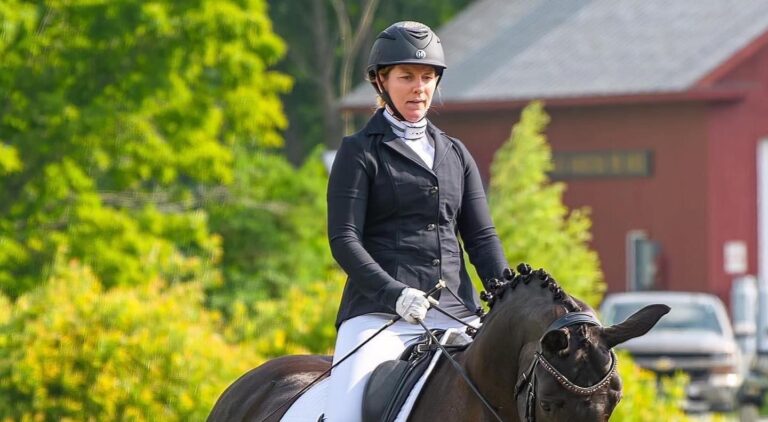
This picture shows Meghan Drysdale on her horse Wrosetta GGF during a Third Level championship class. The photo is taken just in the moment she starts to ask for haunches-in.
When I look at Wrosetta, I notice a very balanced horse, and I really like the attitude and concentration this picture shows. Wrosetta is working in a supple way with nice engagement, a good frame and self-carriage.
The quality of the lateral exercises is always linked with the ability of the horse to balance and maintain a good self-carriage and lift of the shoulders while bending. I can see how Wrosetta’s inside hind leg is already moving to an inside track while the outside shoulder remains moving forward. This start of haunches-in looks balanced, active and well-prepared.
Meghan shows the same concentration and forward attitude in her seat. I especially like the way she is using her outside hand. This looks like she is supporting and driving the horse with a good balance and contact on the outside rein. Her arm is pushing forward while providing stability. By doing this, she allows the bend and enhances the horse’s balance and self-carriage.
In her upper body, I notice that she has a forward tendency, which helps her for a correct shift of weight in the rotation in her body and makes it easier for the horse to bend. She just needs to be careful not to move too far forward because that will cause her outside leg (like a balance reaction) to slide too far back. With a correct forward and sideways shift of her seat, there should be no need for her to take her lower leg farther back. Her whole leg, starting from the pelvis, can support the bend of the horse and control his hind legs.
To feel this, try the following exercise: Stand on the ground with both of your feet hip-width apart. Shift your weight slightly forward to the balls of your feet and then turn slightly to one side and allow your feet to slide and rotate on the ground. When you now look down, your weight should be over your inside leg and your outside leg should be about one hand-width farther behind. This shows how a correct shift of weight from the pelvis influences your leg position. When you are riding, notice that when you position your outside leg from your pelvis downward, it is easy to maintain a long leg position and keep your heel down. Conversely, when you position your outside leg from the knee down and you bring your lower leg back, your heel automatically comes up and your ankle cannot stay supple. This is a small tip that may help Meghan improve her outside leg so that it can perform as well as her hands and arms.
I wish Meghan and her charming horse all the best with many more harmonious rides and success on their way up the levels.
Susanne von Dietze is a leader in equestrian biomechanics. A physiotherapist, licensed Trainer A instructor and judge for dressage and show jumping, she gives lectures and seminars throughout the world, including at the prestigious German Riding Academy in Warendorf. She is a native of Germany and now lives with her husband and three children in Israel, where she competes at the international level. She is the author of two books on the biomechanics of riding: Balance in Movement and Rider and Horse, Back to Back. Find her books at www.EquineNetworkStore.com.
Send Your Photo!
You can submit your high-resolution dressage photo for critique (300 dpi and 4 by 6 inches in size). Or you can send your photo with a link to a short video. Email to DressageToday@AimMedia.com. Turnout in dressage show or clinic-appropriate attire is encouraged. Don’t forget your helmet!











